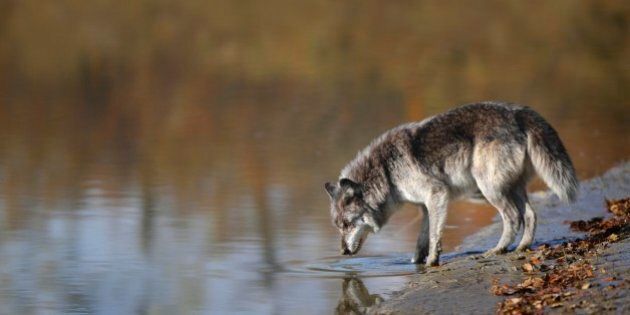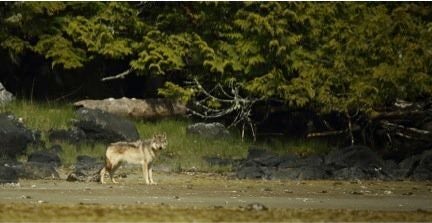
Wolf Awareness has erected a double-sided billboard along Alberta's Highway 2 between Calgary and Red Deer alerting visitors and residents alike to the province's misguided war on grey wolves. The billboard highlights the dire situation wolves are facing and heightens awareness about preserving this ecologically influential species as an important part of Alberta's intact environments.
Grey wolves in Alberta are exposed to lethal threats from every angle, including aerial gunning from helicopters, choking neck-snares, and poison-baits that lure wolves and many other species to their excruciating deaths. Alberta's liberal hunting and trapping regulations, as well as unregulated private bounties, assure that the devastation of wolf families occurs nearly year-round.
Under the pretext of protecting caribou in habitat that is 95 per cent disturbed by oil and gas development, more than 800 wolves in the Little Smoky area were strangled by snares, gunned down from helicopters, and poisoned with strychnine over a period of seven years. Many biologists and wildlife experts consider these killing methods as inhumane and unethical. Notably, caribou are endangered not because of wolves, but because the province has knowingly allowed industry to destroy essential caribou habitat for decades.
Snares intended for wolves "accidentally" killed at least 676 other animals, including two caribou. In a recent review of trapping as a wildlife management technique by Dr. Gilbert Proulx and co-authors, "Humaneness and selectivity of killing neck snares used to capture canids in Canada," published in the Journal of Canadian Wildlife Management and Biology, the authors reveal that Canadian snares are considered inefficient at killing and can cause tremendous pain and enduring suffering to individual animals.
Big Lakes is one example of numerous bounty programs hosted across the province, providing $300 for evidence of each dead wolf since 2010. Other bounties offer $500. Dwight Rodtka, a retired Problem Wildlife Specialist with Alberta Agriculture, reported:
"The municipal district of Big Lakes has claimed 647 wolves in their bounty program in less than five years. During the previous winter, 62 wolves were registered through Alberta Fish and Wildlife by registered trappers in the Sundre and Rocky districts alone. Another 19 wolves were registered as killed by hunters in these areas. These are bare minimums."
In those districts alone, the combined mortalities are equivalent to ten or more wolf packs being destroyed or facing the trauma of having individual wolves taken from their family and purposeful way of living.
Alberta is the only province within Canada that still uses strychnine to kill wolves and coyotes. It is past time to ban these dangerous toxins from the country, as others have done. Knowing how many animals in addition to wolves died because of strychnine poisoning in the Little Smoky area is impossible because the bodies of victims could not be accounted for.
To reduce predation on a woodland caribou population threatened by industrial disturbance, a recent study in Alberta used strychnine baits to kill wolves, even though its use has been largely abandoned. Raincoast Conservation Foundation scientists Dr. Paul Paquet and Dr. Chris Darimont, and colleagues, have recently published a comment in Environmental Conservation detailing the reasons why the use of strychnine to control wolf populations is biologically and ethically unacceptable.
Death by strychnine ingestion is inhumane, as it causes frequent periods of tetanic seizures, occasional cessation of breathing, hyperthermia, extreme suffering, and death from exhaustion or asphyxiation, which typically occurs within 1-2 hours of the onset of clinical signs. However, death can take up to 24 hours or longer if the dose is low.
Not only is the use of strychnine inhumane, but it is in contravention of Canadian Council on Animal Care guidelines and other veterinary associations.
Furthermore, the use of strychnine is non-selective to wolves as individual deaths and population level effects in other animals (for example wolverines, fishers and foxes) are often seen. Since strychnine is highly persistent in poisoned animals, their carcasses remain highly toxic which can kill even more non-target scavengers.
Raincoast large carnivore experts Dr. Heather Bryan and the aforementioned Dr. Paquet, along with colleagues at the University of Calgary and Bar-Ilan University, Israel, have authored a seminal scientific paper, published in the British journal Functional Ecology, which suggests wolves that are heavily hunted or subjected to intensive lethal control experience significant social and physiological stress. The scientists used tufts of hair to measure hormone levels in wolves subject to different hunting pressures in Canada.
Although the long-term effects of chronically elevated stress and reproductive hormones are unknown, there are potential implications for wildlife health, welfare, long-term survival, and behaviour. The effects of stress are often subtle, but the ensuing harm can be acute, chronic, and permanent, sometimes spanning generations.
Ignored in all the killing is the evidence that exploited wolf populations lead to smaller and unstable packs, smaller territories, and potentially more prey killed per capita by these inexperienced wolf packs. All of this can and does increase conflicts with humans, who see wolves as competitors for livestock as well as wild game.
Wolves are now recognized globally as a predator that plays a key role in the top down regulation of ecosystems, yet they still struggle to find safety in most parts Alberta. Will the province's new leaders have the vision to right the wrongs being done to this highly persecuted species? The opportunity and choice to do things differently still remains.
Versions of this article recently ran in the Calgary Herald and Edmonton Journal.
ALSO ON HUFFPOST:
